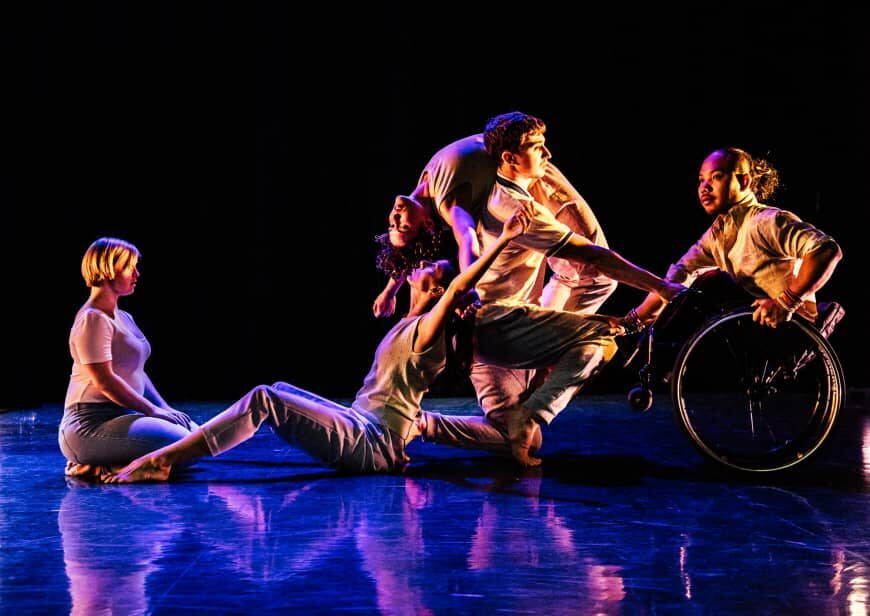“I believe people with almost any kind of physique can do contemporary dance. Yet though there are many courses for able-bodied people, there is almost nothing for people with disabilities,” says Sho Shibata, executive producer of U.K.-based Stopgap Dance Company.
Stopgap’s debut Japan tour with its international hit, The Enormous Room, illustrates how dance can be open to all. Dave Toole, its male lead, has no legs, and Hannah Sampson, the female lead, has Down syndrome.
The company’s acclaimed productions, such as this—which drew rapturous applause in Yokohama ahead of upcoming shows in Tokyo and Kitakyushu—are made possible because of their innovative concept of “inclusive dance.”
This concept—which involves disabled and able-bodied people collaborating together—has been a Stopgap trademark since it started in 1995 as a community project in the country town of Farnham in southern England. Even now, as a fully professional company, it still remains committed to that same pioneering inclusive approach.
Stopgap also runs inclusive-dance workshops around the U.K. and while on tour abroad, as it will this time in Japan following a trailblazing trip in 2008 by some members who came here purely to showcase that side of the company’s activities.
Shibata, 36, now a performing arts executive in England, was born in Japan and became a child actor in Japanese movies, TV dramas and even in a Japanese production of the musical Les Miserables. But then, aged 12, he stepped out of the spotlight when his parents sent him to school in England, where he has lived ever since.
After graduating with a degree from the London School of Economics, he worked at the Arts Council England (ACE) before joining Stopgap in 2008 as a project manager. Ahead of the current Japan tour, he spoke to The Japan Times in London—but gently insisted on not being interviewed in English because he needed to practice his “rusty Japanese.”
Recalling what led him to Stopgap, he says, “I studied philosophy and social psychology because I’ve always been interested in distinctions between people, and in discrimination in society. Also, through working with people with disabilities as a volunteer, I became interested in the arts in that field.”
He explains that though Stopgap pioneered its inclusive-dance approach more than 20 years ago, and the U.K. government identified “diversity” and “social justice” as concerns in the 1990s, collaborative dance creation by disabled and able-bodied people has only recently started to spread more widely there.
A key factor behind that, Shibata says, is the effect of the 2012 London Paralympics, particularly dancer Dave Toole’s role in the opening ceremony. Back then, the beautiful, highly mobile floor and aerial performance by Toole stunned millions of viewers worldwide.
“Around that time, ACE also organized lots of programs, including disability arts,” Shibata says. “As a result, disabled artists had a wonderful chance to perform and many people saw them for the first time. Consequently, more people with disabilities have started to dance.”
In response to that upsurge in interest, and to continue countering limited opportunities for people with disabilities Stopgap now puts even more energy into inclusive-dance education and choreography for young disabled people as it tours nationally and abroad.
In particular, Shibata says long-term subsidies from ACE help the company to run systematic courses to foster and train professional dancers. The entry points for these are free community dance programs from which some people are chosen for more formal training. A few are then offered places on Stopgap’s intensive, three-year apprentice course—after which, subject to auditions, they may become full-time members of the company.
Shibata points out that the other two main dancers apart from Toole in The Enormous Room—Hannah Sampson, and wheelchair-user Nadenh Poan—both became professionals that way.
However, he notes that, “If we want to show an ideal and equal real-world society we can’t just present dancers with disabilities. So having disabled and non-disabled dancers performing together on the same stage—with both shining as professional artists—is vital for us.”
During the creation of The Enormous Room, he says the members were looking for a subject that related to everyone regardless of race, nationality or disability—they decided on “death.”
“Our diverse range of members talked about different cultures’ and countries’ customs to do with death, and I explained the memorial service of isshūki (the first anniversary of a person’s death) in Japan that now features in this piece. We also did workshops, interviews and lots of research, and altogether it took more than two years to create this program.”
The upshot is The Enormous Room, in which a father named Dave (played by Toole) and his daughter Sam (Sampson) are overwhelmed with grief after the death of Jackie, his wife and her mother. Afterward, two ghostlike Jackies appear, one representing how Dave saw her and the other Sam’s vision of her. Then, helped by a guide with a cheeky grin called Chock (Poan), Dave and Sam start to come and go between their regular lives and the realm of the two apparitions (played by able-bodied dancers Amy Butler and Elia Lopez).
As Lucy Bennett, Stopgap’s choreographer and artistic director since 2012, told The Guardian: “Integrated dance for us is about discovering new and unusual dance vocabularies. We often convey this by saying: ‘Difference is our means and our method.'”
In The Enormous Room, she manipulates individuals’ vocabularies to create this touching dance-drama that looks sure to appeal to dance lovers, movie fans, and theatergoers.
“I look forward to meeting lots of Japanese audience members and workshop participants,” Shibata says. “I’m sure many people will be amazed by our performance and I hope we’ll see a positive inclusive-dance takeup for the 2020 Tokyo Olympics and Paralympics.”
The Enormous Room runs March 8 and 9 at Setagaya Public Theatre in Setagaya Ward, Tokyo; and March 16 at Kitakyushu Performing Arts Centre in Kitakyushu, Fukuoka. For more details, visit setagaya-pt.jp.
This article first appeared in The Japan Times on March 6, 2019, and has been reposted with permission.
This post was written by the author in their personal capacity.The opinions expressed in this article are the author’s own and do not reflect the view of The Theatre Times, their staff or collaborators.
This post was written by Nobuko Tanaka.
The views expressed here belong to the author and do not necessarily reflect our views and opinions.

















